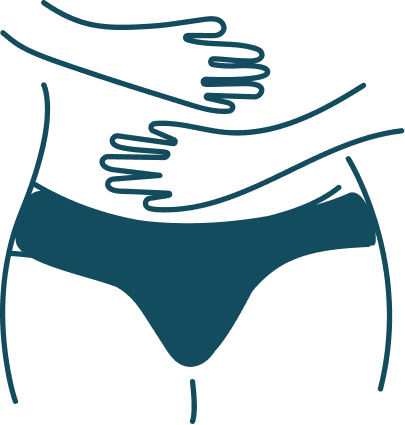A gynaecologist’s guide to managing period pain
Written by
Dr Georgina Leslie, Clinical Lead at Bloomful
Updated on
1 Dec 2022
It probably won’t surprise you to hear that 9 out of 10 women in the UK suffer from period pains. Dysmenorrhoea (the medical term for period pain) has such a huge impact that 57% of women say it's affected their ability to work at some point.
Why is my body tormenting me?
At the end of your menstrual cycle, your body recognises you’re not pregnant and, as a result, begins releasing hormone-like substances called prostaglandins. Now, the uterus is made of muscle (remember: it’s designed to push a baby out) and when these prostaglandins are released, they cause this muscle to squeeze and contract.
Meanwhile, the blood that normally flows to the uterus lining (the endometrium) is cut off, causing this lining to shed and flow through the vagina in the form of menstrual blood.
Both of these events (uterus contractions and endometrium shedding) can cause painful cramps.
There are also gynaecological conditions that can cause or contribute to period pain, which we’ll cover below.

Should I be on red alert?
Doctors divide period pain into two categories:
Primary dysmenorrhoea: pain that usually starts the first day of your period and has no underlying cause.
Secondary dysmenorrhea: pain that is fully or partially caused by a medical condition. This condition could be contributing to your menstrual symptoms in the form of pain, heaviness, duration, or irregularity.
Signs you should be checked by a doctor include:
- Experiencing pain that can’t be managed with simple painkillers such as ibuprofen or paracetamol.
- Having to take time off work because of the pain.
- Pain that starts several days before your period is due.
- Pain that’s still there when your period has ended.
- Experiencing pain during sex, when you empty your bowels (are pooping) or when you empty your bladder (going for a pee).
Which conditions cause period pain?
Endometriosis
This is a long-term condition which occurs when cells similar to those that line the uterus are found outside the uterus in other parts of the body (for example, on your ovaries). These deposits respond to your cycle, growing and shedding as your hormones fluctuate throughout the month, which can cause intense pain. They also leave scarring, which can produce pain outside your period, and can lead to pain that feels different and arises in odd places (for example, when you pee/poo or have sex).
Adenomyosis
Similar to endometriosis, adenomyosis is when cells that normally form a lining on the inside of the uterus grow in the muscle wall of the uterus. Though the pain can be very intense, it tends to arise during your period.
Pelvic inflammatory disease (PID)
PID develops when an infection spreads from the vagina to the upper reproductive organs. It’s usually caused by the sexually transmitted infections chlamydia or gonorrhoea. PID can cause a more painful or heavier period and can also bring on pain unrelated to your period. Sometimes unusual discharge can occur, but not always. PID symptoms tend to come out of the blue, rather than being long-term.
Fibroids
These are non-cancerous growths or lumps of muscle tissue that form within the walls of the uterus. They can make the lining of the uterus larger or the overall size of the uterus bigger. They tend to make your period heavier and more painful as a result.

What about other pain points?
Because of the way your nervous system is wired, the pain from your uterus can affect other areas of your body, including your lower back and legs. Your gut can also react to the release of prostaglandins, leading to looser stools, diarrhoea, and nausea. Similarly, the surge in prostaglandins can cause an inflammatory response, which you might experience as a headache, ache, or pain in your body.
Premenstrual symptoms (PMS) are different and are a result of hormonal changes that occur before your period. Symptoms include weight gain, bloating, irritability, and fatigue. PMS often starts one to two weeks before your period starts.
How can I alleviate my symptoms?
Firstly, if your period pain is getting in the way of daily activities or you’re experiencing the symptoms mentioned above, it’s important to speak to your GP or a gynaecologist. GPs can carry out investigations and start treatments so don’t be put off or worried about a long wait to see an NHS gynaecologist. It’s important to eliminate and treat any gynaecological conditions that your symptoms might be caused by.
Most treatments take a few menstrual cycles/months to really establish, so make sure you have enough 'data' before deciding whether a treatment is right for you. If you're not seeing an improvement then head back to your GP for a further consultation. Read our guide on how to make the most of your GP appointment, especially if you’ve found it difficult to get answers to your gynae questions.

Brighter days ahead …
For most women, taking painkillers such as paracetamol or ibuprofen is enough to calm things down (you can even take both of these at the same time). Many of us, however, will need to find other solutions. Here’s what your GP might suggest:
Non-hormonal medication
Mefenamic acid and tranexamic acid are commonly prescribed by doctors. The first is a stronger painkiller from the ibuprofen ‘family’. The second helps reduce the amount you bleed and, as a result, the intensity of the pain.
Hormonal medication
Contraceptive medications or devices (such as the coil) are often used to reduce how much you bleed and, as a result, the amount of pain you experience. They can also stop your periods altogether. This is an especially good treatment for anyone with an underlying condition such as endometriosis or adenomyosis, because, in addition to suppressing symptoms in the short-term, it can also prevent them from worsening in the long-term.
Alternatives to medication
- A hot (but not too hot!) water bottle. Temperature and pain travel through the same nerve pathways, so you can trick your body by dulling the pain with heat. Make sure it’s not too hot otherwise it can scald your skin.
- Drink plenty of water and avoid things that dehydrate you (eg alcohol, caffeine). This helps promote blood flow and relax those cramping muscles. It can also flush out prostaglandins circulating in your system.
- Be mindful of foods that can promote inflammation (avoid processed, salty and dairy-rich foods). Reach instead for options that reduce inflammation, such as healthy fats and vegetables. Papaya, avocado, nuts, seeds, fish, leafy greens, brown rice, and olive oil are good go-tos.
- A good night’s sleep can lower your stress, helping your body cope with pain better.
- Gentle exercises such as yoga and swimming help your blood flow to those cramping muscles. They also encourage your body to release endorphins that can ease the pain. Try some pelvic physiotherapy exercises to loosen pelvic ligaments and muscles.
- Some people also find herbal teas, essential oil massage, nerve stimulators (TENS) or CBD-infused tampons helpful.
Key takeaways
- While period pain is common, it can point to an underlying condition. Continue to advocate for yourself in medical settings so that your symptoms can be investigated and matched to a treatment that works for you.
- If you do have an underlying condition, it’s important to start a treatment that can contain and even prevent long-term effects on your health and wellbeing.
- Treatments can take time to work, so do give them a few months/menstrual cycles to see if they have a positive impact.
Care from the comfort of your home
When was the last time you felt truly heard by a healthcare professional?
At Bloomful, our clinicians listen deeply, ask the right questions, and commit to helping you overcome the health hurdles that are holding you back.
